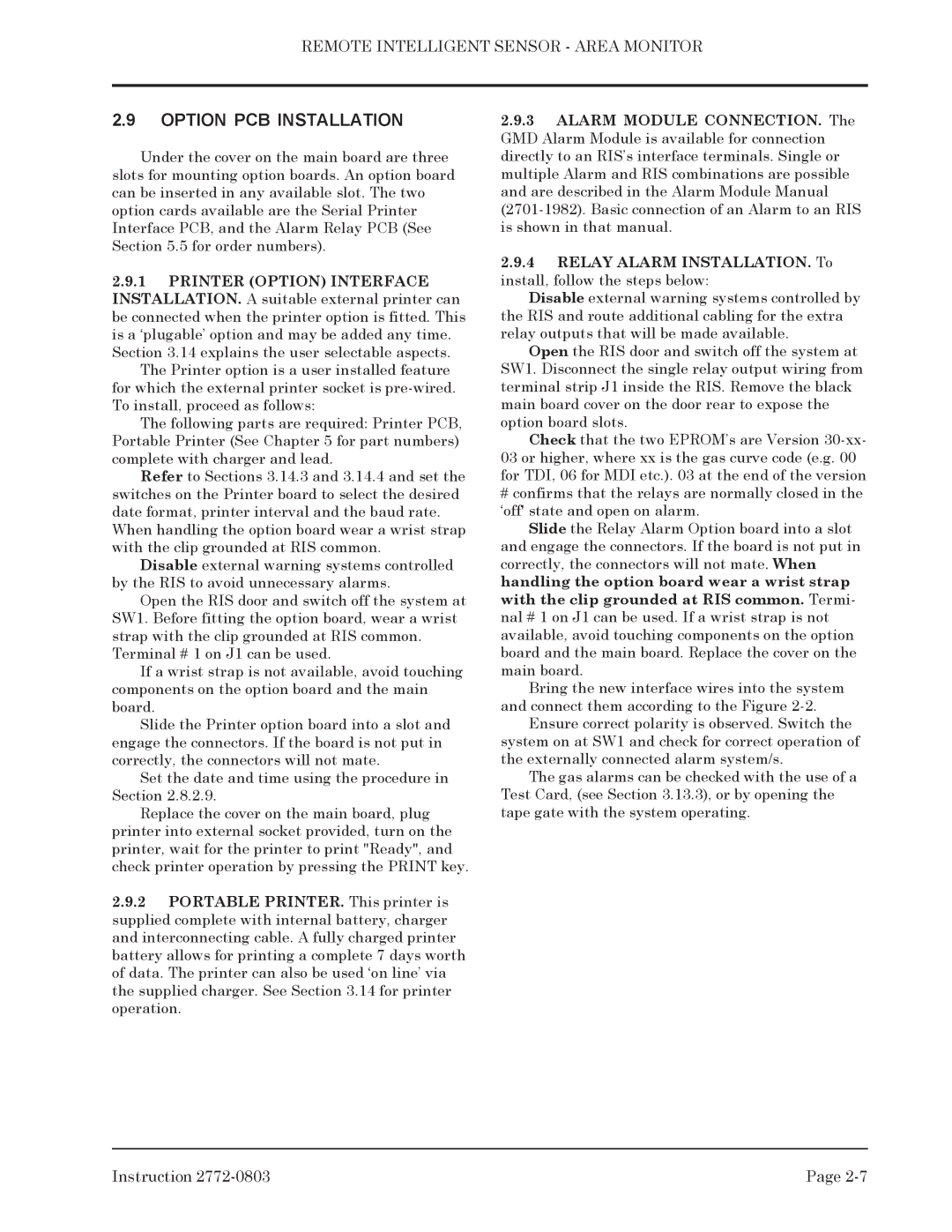
REMOTE INTELLIGENT SENSOR - AREA MONITOR
2.9OPTION PCB INSTALLATION
Under the cover on the main board are three slots for mounting option boards. An option board can be inserted in any available slot. The two option cards available are the Serial Printer Interface PCB, and the Alarm Relay PCB (See Section 5.5 for order numbers).
2.9.1PRINTER (OPTION) INTERFACE INSTALLATION. A suitable external printer can be connected when the printer option is fitted. This is a ‘plugable’ option and may be added any time. Section 3.14 explains the user selectable aspects.
The Printer option is a user installed feature for which the external printer socket is
The following parts are required: Printer PCB, Portable Printer (See Chapter 5 for part numbers) complete with charger and lead.
Refer to Sections 3.14.3 and 3.14.4 and set the switches on the Printer board to select the desired date format, printer interval and the baud rate.
When handling the option board wear a wrist strap with the clip grounded at RIS common.
Disable external warning systems controlled by the RIS to avoid unnecessary alarms.
Open the RIS door and switch off the system at SW1. Before fitting the option board, wear a wrist strap with the clip grounded at RIS common. Terminal # 1 on J1 can be used.
If a wrist strap is not available, avoid touching components on the option board and the main board.
Slide the Printer option board into a slot and engage the connectors. If the board is not put in correctly, the connectors will not mate.
Set the date and time using the procedure in Section 2.8.2.9.
Replace the cover on the main board, plug printer into external socket provided, turn on the printer, wait for the printer to print "Ready", and check printer operation by pressing the PRINT key.
2.9.2PORTABLE PRINTER. This printer is supplied complete with internal battery, charger and interconnecting cable. A fully charged printer battery allows for printing a complete 7 days worth of data. The printer can also be used ‘on line’ via the supplied charger. See Section 3.14 for printer operation.
2.9.3ALARM MODULE CONNECTION. The GMD Alarm Module is available for connection directly to an RIS’s interface terminals. Single or multiple Alarm and RIS combinations are possible and are described in the Alarm Module Manual
2.9.4RELAY ALARM INSTALLATION. To install, follow the steps below:
Disable external warning systems controlled by the RIS and route additional cabling for the extra relay outputs that will be made available.
Open the RIS door and switch off the system at SW1. Disconnect the single relay output wiring from terminal strip J1 inside the RIS. Remove the black main board cover on the door rear to expose the option board slots.
Check that the two EPROM’s are Version
# confirms that the relays are normally closed in the ‘off' state and open on alarm.
Slide the Relay Alarm Option board into a slot and engage the connectors. If the board is not put in correctly, the connectors will not mate. When handling the option board wear a wrist strap with the clip grounded at RIS common. Termi- nal # 1 on J1 can be used. If a wrist strap is not available, avoid touching components on the option board and the main board. Replace the cover on the main board.
Bring the new interface wires into the system and connect them according to the Figure
Ensure correct polarity is observed. Switch the system on at SW1 and check for correct operation of the externally connected alarm system/s.
The gas alarms can be checked with the use of a Test Card, (see Section 3.13.3), or by opening the tape gate with the system operating.
Instruction | Page |
